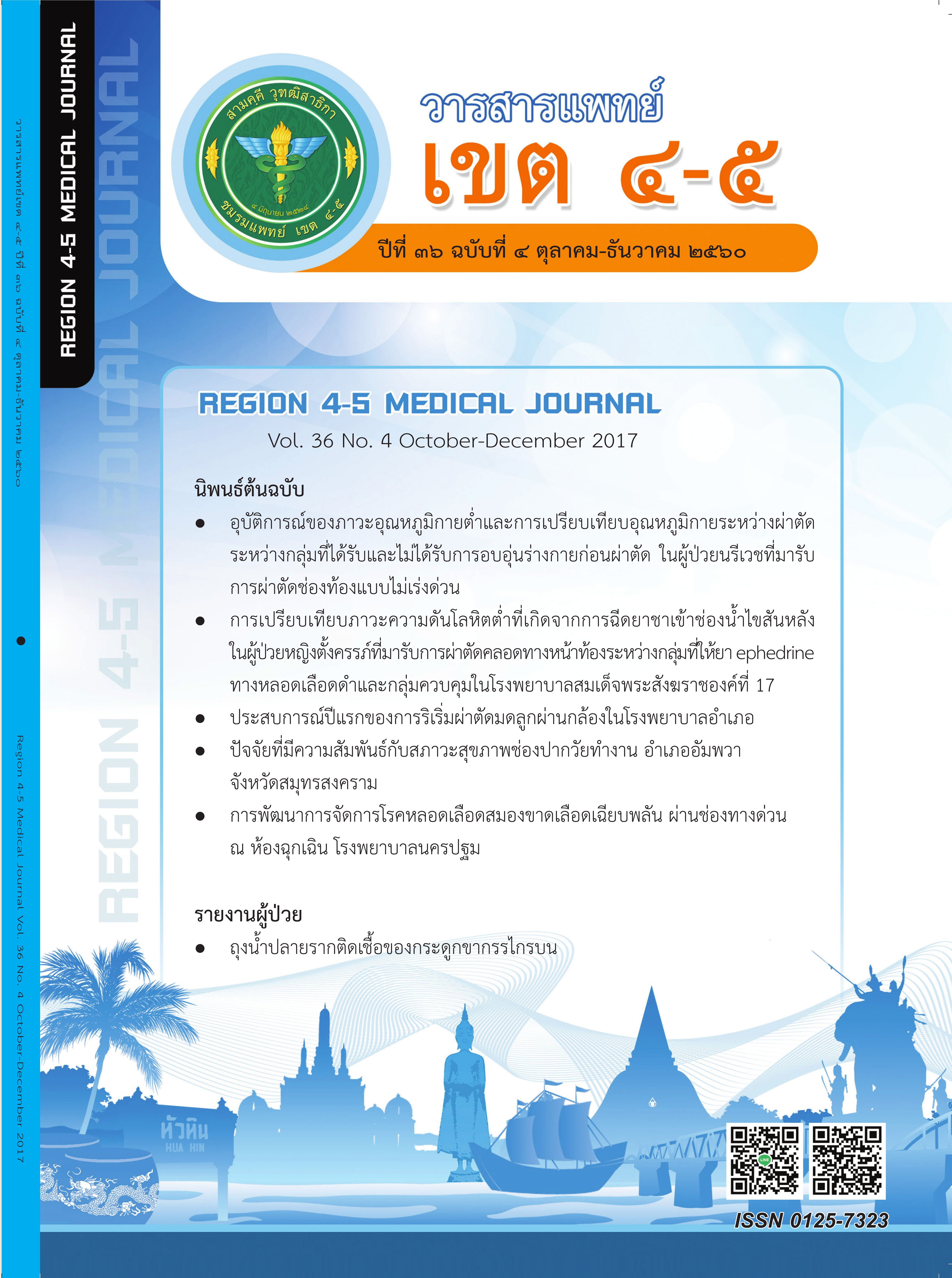การเปรียบเทียบภาวะความดันโลหิตต่ำที่เกิดจากการฉีดยาชาเข้าช่องน้ำไขสันหลังในผู้ป่วยหญิงตั้งครรภ์ที่มารับการผ่าตัดคลอดทางหน้าท้องระหว่างกลุ่มที่ให้ยา ephedrine ทางหลอดเลือดดำและกลุ่มควบคุม ในโรงพยาบาลสมเด็จพระสังฆราชองค์ที่
บทคัดย่อ
ภูมิหลัง: การฉีดยาชาเข้าช่องน้ำไขสันหลังเป็นวิธีที่นิยมในการให้การระงับความรู้สึกเพื่อผ่าตัดคลอดทาง หน้าท้อง แต่ภาวะความดันโลหิตต่ำกลับเป็นปัญหาที่พบบ่อยและก่อให้เกิดผลเสียต่อทั้งมารดาและทารก ยาตีบหลอดเลือดเป็นวิธีหนึ่งที่มีประสิทธิภาพมากที่สุดในการป้องกันและรักษาภาวะความดันโลหิตต่ำ
วัตถุประสงค์: เพื่อเปรียบเทียบภาวะความดันโลหิตต่ำที่เกิดจากการฉีดยาชาเข้าช่องน้ำไขสันหลังระหว่างกลุ่มที่ให้ ephedrine10-15 มก.ทางหลอดเลือดดำและกลุ่มควบคุม
วิธีการ: เป็นการศึกษาเปรียบเทียบแบบย้อนหลัง ในผู้ป่วยหญิงตั้งครรภ์ 1,042 ราย ที่ได้รับการฉีดยาชาเข้าช่องน้ำไขสันหลังเพื่อผ่าตัดคลอด โดยเก็บข้อมูลตั้งแต่มกราคม 2559 ถึงธันวาคม 2559 ผู้ป่วยถูกแบ่งเป็น 2 กลุ่ม คือกลุ่มควบคุมและกลุ่มที่ให้ยา ephedrine 10-15 มก. เพื่อป้องกันภาวะความดันโลหิตต่ำ ข้อมูลถูกนำมาวิเคราะห์ด้วย จำนวน, ร้อยละ, ค่าเฉลี่ย, ส่วนเบี่ยงเบนมาตรฐาน, unpaired t-test และ chi-square test
ผลการศึกษา: พบอุบัติการณ์เกิดความดันโลหิตต่ำในกลุ่มควบคุมมากกว่ากลุ่มที่ได้รับยา ephedrine ทาง หลอดเลือดดำ (ร้อยละ 68.9 และ 38.7; p<0.001) และอุบัติการณ์คลื่นไส้ อาเจียนทั้งระหว่างและหลังผ่าตัดในกลุ่มควบคุมสูงกว่าด้วยเช่นกัน ( ระหว่างผ่าตัดร้อยละ 4.95 และ 0.19 ตามลำดับ; p<0.001, หลังผ่าตัดร้อยละ 22.57 และ 12.3 ตามลำดับ; p< 0.001) แต่การใช้ปริมาณยาตีบหลอดเลือดในกลุ่มควบคุมกลับต่ำกว่ากลุ่มที่ได้รับยา ephedrine ทางหลอดเลือดดำ (ephedrine, 8.37±8.82 มก. และ 10.68±3.23 มก. ตามลำดับ; p<0.001, norepinephrine, 13.13±13.74 มคก. และ 19.99±18.08 มคก. ตามลำดับ; p<0.001) ไม่มีความแตกต่างกันของ neonatal outcome (Apgar ที่ 1,5,10 นาทีในกลุ่มควบคุม 8.92±0.53, 9.90±0.57, 9.94±0.52 และในกลุ่มที่ได้รับยา ephedrine ทางหลอดเลือดดำ 8.91±0.53, 9.91±0.54, 9.95±0.48; p= 0.898,0.783,0.718 ตามลำดับ) และไม่พบภาวะความดันโลหิตสูงในทั้ง 2 กลุ่ม
สรุป: การให้ ephedrine ป้องกัน สามารถป้องกันการเกิดความดันโลหิตต่ำที่เกิดจากการฉีดยาชาเข้าช่อง น้ำไขสันหลังเพื่อผ่าตัดคลอดทางหน้าท้องได้อย่างมีประสิทธิภาพ ทั้งยังลดภาวะคลื่นไส้ อาเจียนในระหว่างผ่าตัดและหลังผ่าตัดได้อีกด้วย สามารถนำมาปรับใช้เป็นแนวทางปฏิบัติในโรงพยาบาล เพื่อผลประโยชน์แก่ผู้ป่วยต่อไป
เอกสารอ้างอิง
2. Heesen M, Klimek M, Hoeks SE, et al. Prevention of spinal anesthesia induced hypotension during cesarean delivery by 5-hydroxytryptamine-3 receptor antagonists: A systematic review and meta-analysis and meta-regression. Anesthesia&Analgesia 2016; 123(4):977-988.
3. Butwick AJ, Columb MO, Carvalho B. Preventing spinal hypotension during cesarean delivery: what is the latest? British Jounal of Anesthesia 2015; 144(2): 183-6.
4. Ngan Kee WD, Khaw.KS, Ng.FF. Prevention of hypotension during spinal anesthesia for cesarean delivery. Anesthesiology 2005; 103: 744-50.
5. Ngan Kee.WD, Lee.SWY, Tan.PE. Randomized double-blinded comparison of norepinephrine and phenylephrine for maintenance of blood pressure during spinal anesthesia for cesarean delivery. Anesthesiology 2015; 122(4):736-45.
6. Ngan Kee WD, Khaw KS, Lee BB, et al. A dose-response study of prophylactic intravenous ephedrine for the prevention of hypotension during spinal anesthesia for cesarean delivery. Anesth Anal 2000:90; 1390-1395.
7. Kol IO, Kaygusuz K, Gursoy S, et al. The effects of intravenous ephedrine during spinal anesthesia for cesarean delivery: a randomized controlled trial. J Korean Med Sci 2009; 90: 1390-1395.
8. Loughrey.JPR, Walsh.F, Gardiner.J. Prophylactic intravenous bolus ephedrine for elective cesarean section under spinal anesthesia.European Journal of Anesthesiology2002;19(1):63-68.
9. Iqbal MS, Ishaq M, Masoo .A, et al. Optimal dosed of prophylactic intravenous ephedrine for spinal-induced hypotension during cesarean section. Anesthesia, Pain & intensive care 2010; 14(2): 71-75.
10. Siddiqui AS, Salim B, Siddiqui SZ. Comparison of phenylephrine and ephedrine for treating hypotension after spinal anesthesia for cesarean section: A randomized double-blind clinical trial. Anesthesia, Pain & intensive care 2015; 19(1):44-49.
11. Emmett RS, Cyna AM, Simmons SW. Technique for preventing hypotension during spinal anesthesia for cesarean section. The Cochrane Database of systematic reviews 2002; Issue 3; Art.No.CD002251.
12. Lee A, Ngan Kee WD, Gin T. A Quantitative, systematic review of randomized controlled trials of ephedrine versus phenylephrine for the management of hypotension during spinal anesthesia for cesarean delivery. Anesth Analg 2002; 94: 920-926.
13. Ngan Kee WD, Khaw KS, Tan PE et al. Placental transfer and fetal metabolic effects of phenylephrine and ephedrine during spinal anesthesia for cesarean delivery. Anesthesiology 2009; 111: 506-512.
14. Nag DS, Samaddar DP, Chatterjec A, et al. Vasopressors in obstetric anesthesia: A current perspective. World J clin cases 2015; 3(1):58-64.
15. วิสุทธิ์ กังวานตระกูล. การคำนวณขนาดตัวอย่าง(Sample Size Calculation) เพื่อการศึกษาวิจัย. (อินเตอร์เน็ต)2554 เข้าถึงได้จาก: http://home.kku.ac.th/wiskun/451710/SampleSizeCal.pdf.
16. Theerawongseree S. Incidence and risk factors of hypotension after spinal anesthesia for cesarean section at Rayong hospital. Rayong hospital medical journal 2016;15(29):1-13.
17. Banerjee A, Stocche RM, Angle P, et al. Preload or coload for spinal anesthesia for elective cesarean delivery: meta-analysis. Cannadian Journal of Anesth 2010; 57: 24-31.
18. Dyer RA, Reed AR, van Dyk D, et al. Hemodynamic effects of ephedrine, phenylephrine, and the coadministration of phenylephrine with oxytocin during spinal anesthesia for elective cesarean delivery. Anesthesiology 2009; 111: 753-65.
19. Langesaeter E, Rosseland LA, stubhaug A. Continuous invasive blood pressure and cardiac output monitoring during cesarean delivery: a randomized, double-blind comparison of low-dose versus high dose spinal anesthesia with intravenous phenylephrine or placebo infusion. Anesthesiology 2008; 109; 856-63.
20. Chumpathong S, Chinachoti T, Visalyaputra S, et al. Incidence and risk factors of hypotension during spinal anesthesia for cesarean section in Siriraj hospital. J Med Assoc Thai 2006; 89(8): 1127-32.
ดาวน์โหลด
เผยแพร่แล้ว
รูปแบบการอ้างอิง
ฉบับ
ประเภทบทความ
สัญญาอนุญาต
ลิขสิทธิ์บทความเป็นของผู้เขียนบทความ แต่หากผลงานของท่านได้รับการพิจารณาตีพิมพ์ลงวารสารแพทย์เขต 4-5 จะคงไว้ซึ่งสิทธิ์ในการตีพิมพ์ครั้งแรกด้วยเหตุที่บทความจะปรากฎในวารสารที่เข้าถึงได้ จึงอนุญาตให้นำบทความในวารสารไปใช้ประโยชน์ได้ในเชิงวิชาการโดยจำเป็นต้องมีการอ้างอิงถึงชื่อวารสารอย่างถูกต้อง แต่ไม่อนุญาตให้นำไปใช้ในเชิงพาณิชย์




